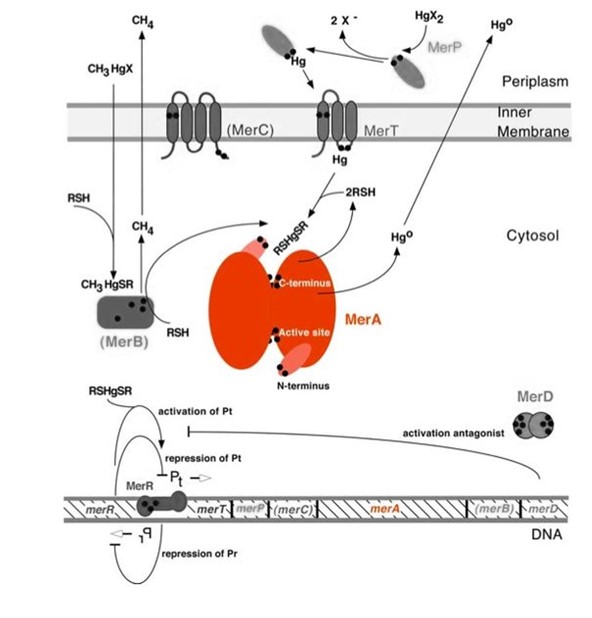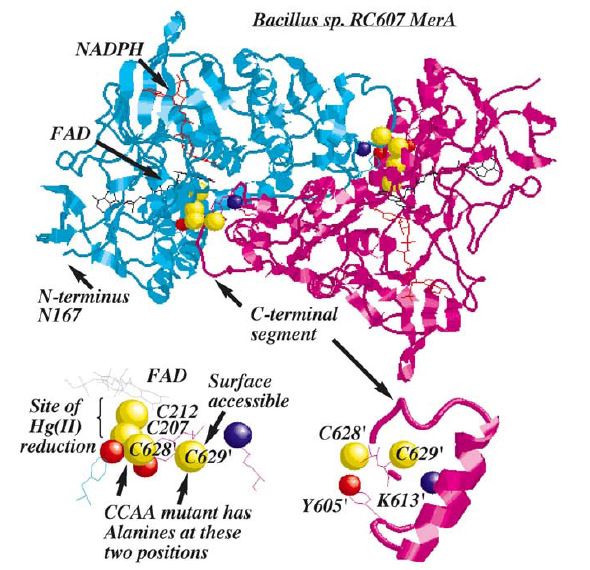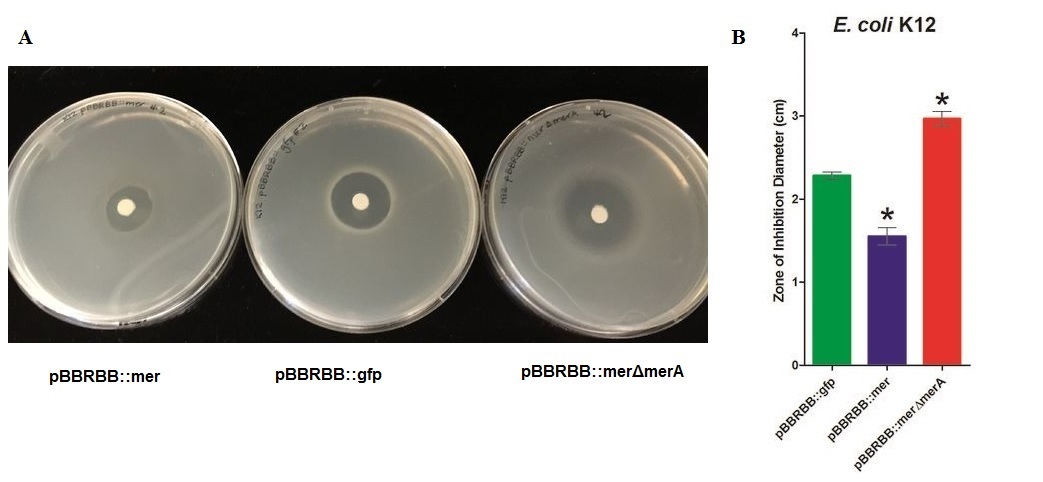Difference between revisions of "Part:BBa K1420001"
(→Characterization of merA) |
(→Characterization of merA) |
||
| Line 52: | Line 52: | ||
'''Figure 2.''' Zones of Inhibition Test For Mercury Resistance. In this assay, ''Escherichia coli'' K12 expressing three different constructs was spread on agar plates to compare level of mercury resistance. Each agar plate contained a filter disk spotted with 10µL of 0.1M HgCl2 in the middle. (A) Agar Plates of K12 with each construct. Left, K12 containing pBBRBB::''mer'' (''mer'' operon); center, K12 containing pBBRBB::''gfp'' (vector control); right, K12 containing pBBRBB::''mer''Δ''merA''(''mer'' operon with ''merA'' deleted). (B) Diameter of zones of inhibition. The diameter of the zone of inhibition was measured in triplicate. Green corresponds to pBBRBB::''gfp'', blue to pBBRBB::''merRTPAB'', and red to pBBRBB::''mer''Δ''merA''. Individual constructs range from highest resistance in the following order: ''merRTPAB'' > vector control >''mer''Δ''merA''. | '''Figure 2.''' Zones of Inhibition Test For Mercury Resistance. In this assay, ''Escherichia coli'' K12 expressing three different constructs was spread on agar plates to compare level of mercury resistance. Each agar plate contained a filter disk spotted with 10µL of 0.1M HgCl2 in the middle. (A) Agar Plates of K12 with each construct. Left, K12 containing pBBRBB::''mer'' (''mer'' operon); center, K12 containing pBBRBB::''gfp'' (vector control); right, K12 containing pBBRBB::''mer''Δ''merA''(''mer'' operon with ''merA'' deleted). (B) Diameter of zones of inhibition. The diameter of the zone of inhibition was measured in triplicate. Green corresponds to pBBRBB::''gfp'', blue to pBBRBB::''merRTPAB'', and red to pBBRBB::''mer''Δ''merA''. Individual constructs range from highest resistance in the following order: ''merRTPAB'' > vector control >''mer''Δ''merA''. | ||
| − | For protocol of zone inhibition test, please click [[ | + | For protocol of zone inhibition test, please click [[*this will link to the protocol page]]. |
''E. coli'' K12 containing the plasmid with the mer operon (pBBRBB:''merRTPAB'') had a smaller zone of inhibition than ''E. coli'' with the vector control indicating that expression of the ''mer'' operon increased resistance to Hg(II) (i.e. allowed cells to grow closer to the Hg(II)-containing disc resulting in a smaller zone of inhibition). ''E. coli'' cells harboring the plasmid containing the mer operon with ''merA'' deleted had the largest zones of inhibition among all three strain tested. This result was expected since cells containing ''merRTPB'' without ''merA'' are able to transport Hg(II) more efficiently into the cell but cannot reduce Hg(II) to the less toxic Hg(0). Therefore, Hg(II) accumulates in cells lacking MerA and hence they are unable to grow near the Hg(II)-containing disc. | ''E. coli'' K12 containing the plasmid with the mer operon (pBBRBB:''merRTPAB'') had a smaller zone of inhibition than ''E. coli'' with the vector control indicating that expression of the ''mer'' operon increased resistance to Hg(II) (i.e. allowed cells to grow closer to the Hg(II)-containing disc resulting in a smaller zone of inhibition). ''E. coli'' cells harboring the plasmid containing the mer operon with ''merA'' deleted had the largest zones of inhibition among all three strain tested. This result was expected since cells containing ''merRTPB'' without ''merA'' are able to transport Hg(II) more efficiently into the cell but cannot reduce Hg(II) to the less toxic Hg(0). Therefore, Hg(II) accumulates in cells lacking MerA and hence they are unable to grow near the Hg(II)-containing disc. | ||
Revision as of 02:39, 14 October 2014
merA, mercuric reductase from Serratia marcescens
Summary
• MerA, a ~120kDa homodimeric mercuric ion reductase, is encoded by merA gene in mer operon.
• MerA reduces Hg(II) to Hg(0) as a means of detoxification.
• MerA and MerB (organomercury lyase) are essential to inorganic and organic mercury resistance.
• Zone of inhibition assays showed that E. coli harboring the mer operon (E. coli pBBRBB::mer) were more resistant to mercuric ions (smallest zone of inhibition) than the vector control (E. coli pBBRBB::gfp). Also, E. coli with the mer operon containing a deletion in merA were more sensitive to mercuric ions (larger zone of inhibition) than E. coli with the entire mer operon and the vector control. This illustrates that when other proteins encoded by the mer operon, MerT and MerP, transport mercury ions into the cell, MerA plays an important role detoxifying Hg(II) to Hg(0).
Overview
Mercury resistance gene merA (1686 bp) encodes MerA, a mercuric ion reductase (cytosolic, flavin disulfide oxidoreductase, ~120kDa), that is essential to bacterial mercury resistance. MerA and gene merA are highlighted in orange in Figure 1. The lower part of Figure 1 shows the arrangement of mer genes in the operon, and merA is located downstream of merT and merP, the genes that encode mercury transport proteins. As shown in Figure 2, the mechanisms essential for mercury resistance are carried out by MerB and MerA. MerB transforms methylmercury to less toxic, non-biomagnified ionic mercury Hg(II), and MerA reduces Hg(II) to the least toxic metallic mercury, Hg(0).
Figure 1. Model of mercury resistance operon. The symbol • indicates a cysteine residue. RSH indicates cytosolic thiol redox buffers such as glutathione. Figure 1 shows the interactions of MerA with mercury compounds and other gene products of mer operon. (This figure is adapted from "Bacterial mercury resistance from atoms to ecosystems". Reference: T. Barkay et al. FEMS Microbiology Reviews 27 (2003) 355-384.)
Nature evolves different mercury detoxification strategies. MerA and MerB confer mercury resistance by coupling reduction of thiol-avid organic mercury species to relatively inert, uncharged, monoatomic mercury. Since organic mercuric species have high affinity to thiol groups and commonly form strong but reversible bonds, cytosolic thiol redox buffers and cysteine residues of mercury binding proteins compete with thiol groups in other proteins and therefore prevent cationic mercury from inhibiting cytosolic machineries. Once the organomercury is converted to ionic mercury by MerB, MerA reduces ionic mercury to volatile, elemental mercury which diffuses through cell membrane without any active transport systems. While MerA and MerB are the key mercury detoxification enzymes, they orchestrate with mercury transport proteins, MerT and MerP, to confer bacterial mercury resistance.
Molecular Function
MerA catalyzes the reduction of mercuric ion released from protonlysis of organomercury (catalyzed by MerB) to the relative inert, volatile monoatomic mercury in a NADPH dependent reaction.
Figure 2. MerA Catalyzed Reaction
Structure and Mechanism
MerA is a 125kDA homodimer.
Characterization of merA
To test the effect of MerA on mercury resistance, we characterized mercury resistance or sensitivity by zone of inhibition tests using the following three strains:
•E. coli K12 pBBRBB::gfp - vector control
•E. coli K12 pBBRBB::mer - mer operon vector (merRTPAB)
•E. coli K12 pBBRBB::merΔmerA- mer operon with merA deleted (merRTPB)
Zone of Inhibition Results
Figure 2. Zones of Inhibition Test For Mercury Resistance. In this assay, Escherichia coli K12 expressing three different constructs was spread on agar plates to compare level of mercury resistance. Each agar plate contained a filter disk spotted with 10µL of 0.1M HgCl2 in the middle. (A) Agar Plates of K12 with each construct. Left, K12 containing pBBRBB::mer (mer operon); center, K12 containing pBBRBB::gfp (vector control); right, K12 containing pBBRBB::merΔmerA(mer operon with merA deleted). (B) Diameter of zones of inhibition. The diameter of the zone of inhibition was measured in triplicate. Green corresponds to pBBRBB::gfp, blue to pBBRBB::merRTPAB, and red to pBBRBB::merΔmerA. Individual constructs range from highest resistance in the following order: merRTPAB > vector control >merΔmerA.
For protocol of zone inhibition test, please click *this will link to the protocol page.
E. coli K12 containing the plasmid with the mer operon (pBBRBB:merRTPAB) had a smaller zone of inhibition than E. coli with the vector control indicating that expression of the mer operon increased resistance to Hg(II) (i.e. allowed cells to grow closer to the Hg(II)-containing disc resulting in a smaller zone of inhibition). E. coli cells harboring the plasmid containing the mer operon with merA deleted had the largest zones of inhibition among all three strain tested. This result was expected since cells containing merRTPB without merA are able to transport Hg(II) more efficiently into the cell but cannot reduce Hg(II) to the less toxic Hg(0). Therefore, Hg(II) accumulates in cells lacking MerA and hence they are unable to grow near the Hg(II)-containing disc.
Sequence and Features
- 10COMPATIBLE WITH RFC[10]
- 12COMPATIBLE WITH RFC[12]
- 21COMPATIBLE WITH RFC[21]
- 23COMPATIBLE WITH RFC[23]
- 25INCOMPATIBLE WITH RFC[25]Illegal NgoMIV site found at 1201
Illegal NgoMIV site found at 1249
Illegal NgoMIV site found at 1311
Illegal NgoMIV site found at 1522 - 1000COMPATIBLE WITH RFC[1000]




